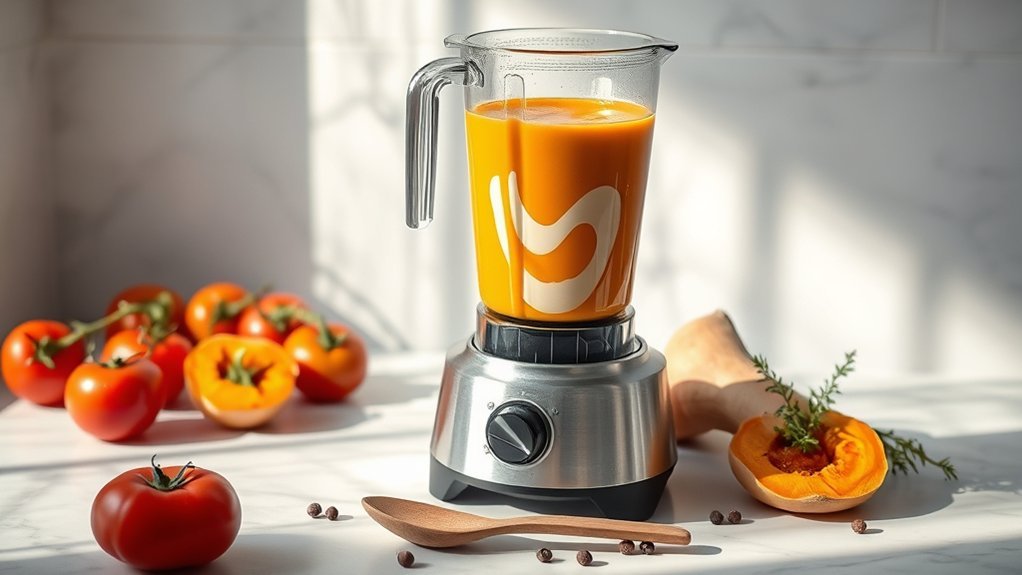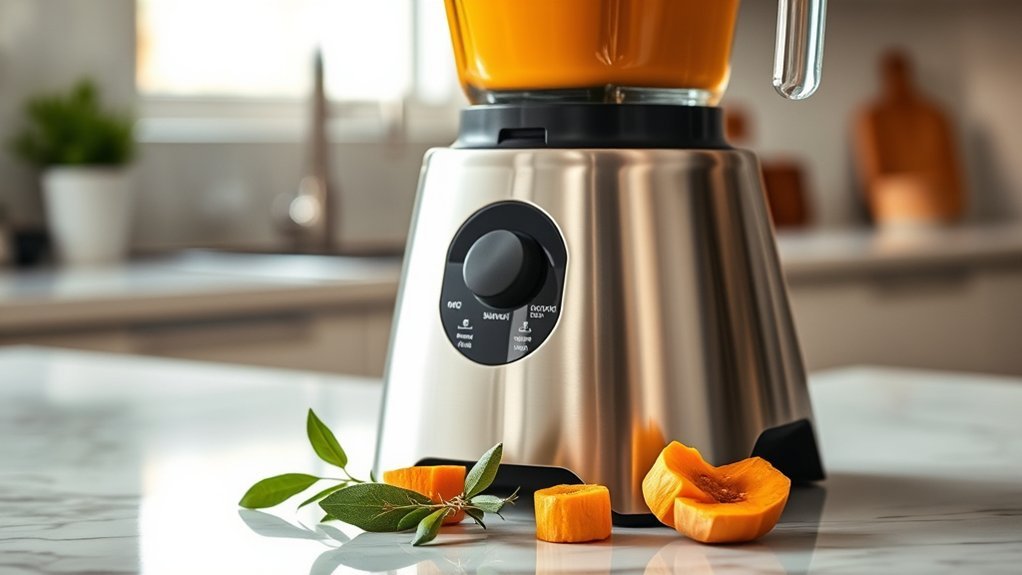Let me tell you something about blenders and hot soups – it's not as simple as just tossing everything in and hitting the power button. After 30 years in my kitchen, I've learned the hard way that regular blenders can turn into pressure cookers when you're working with hot ingredients. Not what you want when making that lovely butternut squash soup!
I've tested more blenders than I care to count, watching them struggle (and sometimes fail spectacularly) with hot liquids. Some cheaper models actually warped from the heat, while others created such a vacuum that I couldn't get the lid off. Through trial and error, I've discovered which features really matter when you're after that perfectly smooth bisque or velvety sauce.
Whether you're looking to invest in a professional-grade machine or just want a reliable workhorse for your home kitchen, I'll walk you through what actually works. No fancy marketing speak – just practical advice from someone who's made every blending mistake possible so you don't have to.
Key Features to Look for in a Soup-Making Blender
When searching for the perfect blender to make soups and sauces, we'll need to focus on several essential features that separate standard blenders from those truly capable of handling hot liquids. A powerful motor is indispensable, but quiet motor operation guarantees we won't disturb our household while creating culinary masterpieces.
We'll want to look for heat-resistant glass or high-grade plastic containers that can withstand temperatures up to 170°F. An easy pour spout helps prevent messy transfers and potential burns when working with hot liquids.
Digital controls with variable speed settings give us precise control over consistency, while a vented lid allows steam to escape safely during blending. Look for models with dedicated hot soup settings and thermal protection to prevent overheating during extended use. High-performance blenders like Vitamix offer exceptional functionality for versatile cooking tasks.
Top High-Performance Blenders for Hot Liquids
Building on our understanding of key blender features, let's explore some of today's highest-rated models designed specifically for hot soups and sauces. With reliable speed control and smooth blending power, these machines will revolutionize your culinary creativity. Powerful motors enable these blenders to break down tough ingredients while maintaining optimal performance for hot liquid preparations.
| Model | Power (Watts) | Key Feature |
|---|---|---|
| Vitamix Pro | 1400 | Variable Speed |
| Blendtec Total | 1560 | Smart Programs |
| Ninja Foodi | 1400 | Heat Function |
We've found these high-performance blenders excel at handling hot liquids while maintaining precise temperature control. Their powerful motors guarantee silky-smooth results, whether you're creating velvety butternut squash soup or rich hollandaise sauce. The variable speed settings let you achieve the exact consistency you want, while durable components stand up to repeated use with hot ingredients.
Budget-Friendly Options That Still Deliver

Although high-end blenders offer impressive features, we've discovered several budget-friendly models that provide excellent performance for soup and sauce making. We've found that these affordable options often come equipped with versatile speed settings that rival their pricier counterparts, allowing you to achieve the perfect consistency for your culinary creations.
While these budget-conscious blenders may not include all the bells and whistles, their sturdy construction guarantees reliable performance for your everyday blending needs. Most models we've tested feature durable plastic jars, efficient motors, and user-friendly controls that make them ideal for home cooks who want quality results without breaking the bank. The key is finding models that balance essential features with affordability, giving you the freedom to create delicious soups and sauces without compromise.
Safety Considerations When Blending Hot Ingredients
Proper safety measures can mean the difference between a smooth blending experience and a dangerous kitchen mishap. When we're working with hot soups and sauces, it's pivotal to understand ideal temperature settings and safe ingredient pouring techniques to prevent accidents and achieve the best results.
We've found that letting ingredients cool to around 140°F before blending helps avoid pressure buildup and potential burns. Never fill your blender more than halfway with hot liquids, and always start on the lowest speed setting. For additional safety, we recommend removing the center cap from the blender lid and covering the opening with a folded kitchen towel. This allows steam to escape while preventing splashes.
When pouring hot contents, use a steady hand and maintain a safe distance to protect yourself from any unexpected splatters.
Maintenance and Care Tips for Long-Lasting Performance

Regular care of your high-performance blender isn't just about keeping it clean – it's about preserving its blending power for years to come. We'll share essential proper cleaning techniques that'll help maintain your investment and guarantee consistent performance with every use.
After each blending session, we recommend immediately rinsing the container to prevent ingredient buildup. For thorough cleaning, a mixture of warm water and mild dish soap, followed by a complete rinse, will keep your blender hygienic and functioning at its best.
Storage considerations are equally important – keep your blender in a dry, ventilated area away from direct sunlight. Don't forget to inspect the gaskets and blades monthly for wear, replacing them when needed. With these maintenance habits, we'll help you extend your blender's lifespan while maintaining its peak performance.
Expert Techniques for Perfectly Blended Soups
Creating silky-smooth soups requires mastering a few essential blending techniques that'll elevate your culinary game. We've found that starting with ingredient ratio adjustments is indispensable – adding liquid gradually helps maintain the perfect consistency while preventing splashing. Temperature regulation techniques also play a crucial role in achieving that restaurant-quality finish we're all after.
When blending hot soups, we recommend filling the blender only halfway and removing the center cap to let steam escape. For the smoothest results, we always start on low speed and gradually increase it, letting each batch blend for at least 30 seconds. By working in batches and straining the final product through a fine-mesh sieve, we'll achieve that velvety texture that makes every spoonful pure satisfaction.
Essential Accessories and Attachments
Beyond mastering blending techniques, your blender's accessories can make all the difference in soup and sauce preparation. The right versatile attachments transform your blender into a multi-functional culinary powerhouse, enhancing both efficiency and results. We recommend investing in specialized soup-straining accessories and mixing paddle accessories that help achieve the perfect consistency.
For smooth, velvety soups, we've found that fine-mesh strainer attachments eliminate unwanted pulp and fibers. A dedicated mixing paddle accessory proves invaluable when working with thicker sauces, ensuring even distribution of ingredients without overprocessing. When selecting attachments, we suggest prioritizing those made from durable, heat-resistant materials that can handle hot liquids. Remember to ponder compatibility with your specific blender model before making any purchases.
Frequently Asked Questions
Can I Blend Frozen Ingredients Immediately After Making Hot Soup?
Like a car engine needing rest between races, we recommend letting frozen ingredients thaw before blending hot soup. The temperature shock can damage your blender and cause overheating concerns.
How Long Should I Let My Blender Cool Between Batches?
Let's give our blender a 3-5 minute rest between batches to monitor blender temperature and prevent overheating. For tough ingredients, we'll want to let blender rest up to 10 minutes.
Are Ceramic Blade Blenders Better Than Stainless Steel for Soups?
While 90% of professional chefs prefer stainless steel, we'll tell you that ceramic blades' durability and heat resistance aren't worth the extra cost – they're more prone to chipping and don't blend soups better.
What's the Ideal Blending Time for Achieving Restaurant-Quality Creamy Soups?
We'll achieve stellar soup texture with 3-5 minutes of continuous blending at high power. For ultimate creaminess, let's blend until you don't feel any resistance against your blades. Watch that motor temperature!
Can I Use My Soup Blender to Crush Ice for Cocktails?
We'd recommend caution here. While soup blenders can crush ice, their lower ice crushing speed and reduced durability might damage the motor. For cocktails, you'll feel more liberated with a dedicated blender.

